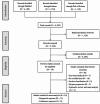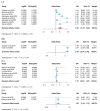The association between screen time exposure and myopia in children and adolescents: a meta-analysis
- PMID: 38890613
- PMCID: PMC11186094
- DOI: 10.1186/s12889-024-19113-5
The association between screen time exposure and myopia in children and adolescents: a meta-analysis
Abstract
Objective: This study aimed to systematically review epidemiological evidence on associations between screen time exposure and myopia in children and adolescents, and to quantitatively evaluate summary effect estimates from existing literature.
Method: There were three online databases including PubMed, Embase, and Web of Science, for epidemiological studies on screen time exposure and myopia published before June 1, 2023. The risk of bias was assessed by the Newcastle Ottawa Scale (NOS) checklist. Summary odds ratios (ORs) and 95% confidence intervals (CIs) were calculated to evaluate the correlation between screen time exposure and myopia using random or fixed-effect models by exposure type (categorical/continuous). We also performed subgroup analysis by screen device type, study quality, geographic region, and research period.
Results: We searched 7,571 records from three databases and identified 19 eligible studies, including 14 high-quality studies and 5 moderate-quality studies. Meta-analyses suggested that there was a statistically significant correlation between screen time (high vs. low) and myopia. The pooled ORs with 95%CIs were respectively 2.24 (1.47-3.42) for cross-sectional studies, and 2.39 (2.07-2.76) for cohort studies. We also found a significant association between continuous exposure to screen time (per 1 h/d increase) and myopia in cohort studies. The pooled ORs with 95%CIs were 1.07 (1.01-1.13). In subgroup analysis stratified by screen device type in cross-sectional studies, screen time exposures from computers (categorical: OR = 8.19, 95%CI: 4.78-14.04; continuous: OR = 1.22, 95%CI: 1.10-1.35) and televisions (categorical: OR = 1.46, 95%CI: 1.02-2.10) were associated with myopia, while smartphones were not. Although publication bias was detected, the pooled results did not show significant changes after adjustment using the trim and fill method.
Conclusion: Our findings support that screen time exposure was significantly associated with myopia in children and adolescents. Notably, screen time exposure from computers may have the most significant impact on myopia.
Keywords: Children; Meta-analysis; Myopia; Public health; Screen time.
© 2024. The Author(s).
Conflict of interest statement
The authors declare no competing interests.
Figures




Similar articles
-
Association between digital smart device use and myopia: a systematic review and meta-analysis.Lancet Digit Health. 2021 Dec;3(12):e806-e818. doi: 10.1016/S2589-7500(21)00135-7. Epub 2021 Oct 5. Lancet Digit Health. 2021. PMID: 34625399
-
Association of physical activity, sedentary behaviour, sleep and myopia in children and adolescents: a systematic review and dose-response meta-analysis.BMC Public Health. 2025 Apr 1;25(1):1231. doi: 10.1186/s12889-025-22434-8. BMC Public Health. 2025. PMID: 40170130 Free PMC article.
-
Screen time and health issues in Chinese school-aged children and adolescents: a systematic review and meta-analysis.BMC Public Health. 2022 Apr 22;22(1):810. doi: 10.1186/s12889-022-13155-3. BMC Public Health. 2022. PMID: 35459156 Free PMC article.
-
Screen Time and Autism Spectrum Disorder: A Systematic Review and Meta-Analysis.JAMA Netw Open. 2023 Dec 1;6(12):e2346775. doi: 10.1001/jamanetworkopen.2023.46775. JAMA Netw Open. 2023. PMID: 38064216 Free PMC article.
-
The association between digital screen time and myopia: A systematic review.Ophthalmic Physiol Opt. 2020 Mar;40(2):216-229. doi: 10.1111/opo.12657. Epub 2020 Jan 13. Ophthalmic Physiol Opt. 2020. PMID: 31943280
Cited by
-
Parental Supervision and Its Impact on Children's Screen Time, Behavior, and Health Outcomes in Duhok City, Iraq: A Cross-Sectional Study.Cureus. 2025 Feb 16;17(2):e79113. doi: 10.7759/cureus.79113. eCollection 2025 Feb. Cureus. 2025. PMID: 40109810 Free PMC article.
-
Association between weekend catch-up outdoor duration and prevalence of myopia: evidence from a cross-sectional, multi-center study in China.BMC Public Health. 2024 Oct 25;24(1):2966. doi: 10.1186/s12889-024-20466-0. BMC Public Health. 2024. PMID: 39455944 Free PMC article.
-
Relationship Between Poor Visual Acuity and Lifestyle: A Longitudinal and Cross-Sectional Study of Japanese Students Using Secondary Data.Cureus. 2025 Mar 3;17(3):e79980. doi: 10.7759/cureus.79980. eCollection 2025 Mar. Cureus. 2025. PMID: 40182380 Free PMC article.
-
Digital Screen Time and Myopia: A Systematic Review and Dose-Response Meta-Analysis.JAMA Netw Open. 2025 Feb 3;8(2):e2460026. doi: 10.1001/jamanetworkopen.2024.60026. JAMA Netw Open. 2025. PMID: 39982728 Free PMC article.
-
Prediction of Myopia Among Undergraduate Students Using Ensemble Machine Learning Techniques.Health Sci Rep. 2025 May 26;8(5):e70874. doi: 10.1002/hsr2.70874. eCollection 2025 May. Health Sci Rep. 2025. PMID: 40432695 Free PMC article.
References
Publication types
MeSH terms
Grants and funding
LinkOut - more resources
Full Text Sources

